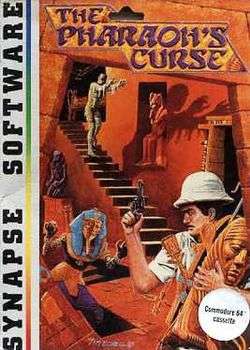Pharaoh's Curse (video game)
 Cover art | |
| Developer(s) | Synapse Software |
|---|---|
| Publisher(s) | Synapse Software |
| Designer(s) | Steve Coleman |
| Platform(s) | Atari 8-bit, C64, VIC-20 |
| Release date(s) | 1983 |
| Genre(s) | Platform game |
| Mode(s) | Single-player |
The Pharaoh's Curse, or simply Pharaoh's Curse, is a 1983 platform adventure game written by Steve Coleman and published by Synapse Software for the Atari 8-bit family. Pharaoh's Curse was ported to the Commodore 64 and VIC-20. Coleman also wrote Rainbow Walker for Synapse.[1]
In Pharaoh's Curse, the player attempts to collect 16 treasures from an Egyptian tomb while avoiding the pharaoh, his mummy, and various traps. The game is similar to Konami's 1982 arcade game Tutankham,[2] and is considered an early example of the Metroidvania genre.[3]
Gameplay

The Pharaoh's Curse world is arranged as a series of 16 rooms in a 4 by 4 layout, using the flip screen technique of moving between them. The game opens with the player on a title screen, and they start the game by running onto the entrance, a pit, and falling into the tombs below. The rooms consist of various levels in a cave-like layout. The player can drop any distance without harm, and can climb back up on the ropes or elevator-like moving platforms that appear on most screens. Each of the rooms contains one of 16 treasures, which provided an extra life when they are retrieved. A display along the top of the screen indicates which treasures still had to be collected.
While playing, two opponents appear regularly, the pharaoh and the mummy, which then chase the player. The player can shoot them, and they both shoot back at a much slower rate. Traps in the map, triggered by walking over visible triggers, tend to be more dangerous. Some triggers are positioned on the tops of elevators or the bottom of drops, making fast action required. Some of the rooms are sealed from each other using magic gates. These can be opened with keys that appear randomly around the map. Lastly, there is a flying creature, the Winged Avenger, which picks the player on contact, carries him through the screens and drops him somewhere. The Avenger can carry the player to areas that are otherwise unavailable due to the layout or a lack of keys.
Once all treasures have been collected, the player must escape back to the starting screen. Subsequently, they receive a level password and the game restarts in a higher of the four difficulty levels.
Reception
Antic gave the game a favorable review, saying "Pharaoh's Curse will appeal to all computerists and gamesters... It's another winner from Synapse."[4] HI-Res said "This Tutankham takeoff is marvelous and the Joystick capability is magnificent."[2] Personal Computer Games gave the VIC-20 version an 8 out of 10 rating, saying "The basic idea behind Pharaoh's Curse isn't particularly new, but there are enough original touches to give a unique feel to the game. The program is visually attractive, easy to grasp, and great fun to play."[5] They later awarded it the title of VIC-20 game of the year.[6]
The game is well known in retrogaming circles as well. Defunct Games gave it a B grade, saying it held a special place in his heart and that "I remember an ever-present desire to play this game whenever I had the chance."[7]
References
- ↑ "The Giant List of Classic Game Programmers".
- 1 2 Nicholson, Reid (May–June 1984). "Pharaoh's Curse". HI-Res: 14.
- ↑ Szczepaniak, John. "Backtracking: The History of Metroidvania". GamesTM (116). Imagine Publishing. pp. 148–53.
- ↑ Wolford, Roy (July 1983). "The Pharaoh's Curse". Antic.
- ↑ "VIC-20: Pharaoh's Curse". Personal Computer Games. 1984.
- ↑ "Game of the Year". Personal Computer Games: 36. January 1985.
- ↑ Despain, Josh (14 January 2014). "Pharaoh's Curse".